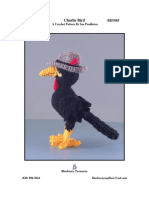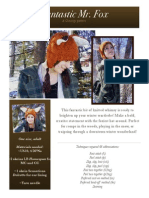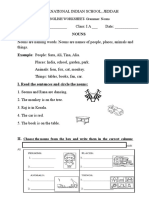R2 Toadstool
The Toadstool or Fly Agaric is one of the most recognisable types of fungi. In this
pattern we will knit a red cap and then embroider the white spots as French Knots.
Don't worry if you can't sew French Knots – this is the perfect chance to learn. Partly
because the toadstool will look more natural if your spots are uneven, and partly
because you tie a lot of them to cover the cap!
You will need:
red and white dk yarn • white paper (optional) • toy stuffing
4 x double ended knitting needles (3mm) • tapestry needle • scissors
Pattern (Closed Cap):
Cast on 32sts in red. Join into the round Round 21: [p2tog, p4] x 4 (20)
and work as follows: Round 22: [p2, p2tog, p1] x 4 (16)
Round 23: [p2tog, p2] x 4 (12)
Rounds 1-14: p – Round 24: [p1, p2tog] x 4 (8)
Round 15: [p6, p2tog] x 4 (28) Round 25: p–
Rounds 16-18: p –
Round 19: [p2, p2tog, p3] x 4 (24) Thread yarn through remaining sts and pull
Round 20: p – tight.
Pattern (Open Cap):
Cast on 76sts in red. Join into the round Round 11: [p2, p2tog, p6] x 4 (36)
and work as follows: Round 12: [p4, p2tog, p3] x 4 (32)
Round 13: [p6, p2tog] x 4 (28)
Round 1: p – Round 14: [p1, p2tog, p4] x 4 (24)
Round 2: [p2tog, p17] x 4 (72) Round 15: [p3, p2tog, p1] x 4 (20)
Round 3: [p4, p2tog, p12] x 4 (68) Round 16: [p2tog, p3] x 4 (16)
Round 4: [p8, p2tog, p7] x 4 (64) Round 17: [p2, p2tog] x 4 (12)
Round 5: [p12, p2tog, p2] x 4 (60) Round 18: [p2tog, p1] x 4 (8)
Round 6: [p1, p2tog, p12] x 4 (56) Round 19: p–
Round 7: [p3, p2tog, p9] x 4 (52)
Round 8: [p6, p2tog, p5] x 4 (48) Thread yarn through remaining sts and pull
Round 9: [p9, p2tog, p1] x 4 (44) tight.
Round 10: [p2tog, p9] x 4 (40)
w w w. o d d k n i t . c o m/ p a tt e r n s/ fu ng i / t o a d s t o o l . p d f
� Making Up (Caps):
Using a length of the white yarn embroider French Knots all over the red cap. Try to space them a
little unevenly and make the spots of varying sizes. If you would rather tie fewer, larger knots use a
double thickness of white yarn.
Pattern (Closed Cap Stem):
Fill the red cap loosely with toy stuffing. Round 1: k – (16)
Round 2: [k2tog, k2] x 4 (12)
In white yarn pick up 16 sts along the cast
on edge. Work 4 cm straight, then cast off.
Pattern (Open Cap Stem):
In white pick up 76 sts along the cast on The open cap can either be left unstuffed (in
edge of the cap. this case it folds back on itself to form a
slight dome) or lightly filled (the top is held
Round 1: p – relatively flat). Both are stages in the
Rounds 2 to 7: [p1, k1] x 19 toadstool growth pattern.
Round 8: [k2tog, p1, k1] x 19 (57)
Rounds 9 to 11: [k1, p1, k1] x 19 Work 5 cm straight, then cast off.
Round 12: [k1, k2tog] x 19 (38)
Round 13: [k2tog, k17] x 2 (36) Hold the toadstool so that the stem is
Round 14: [k3, k2tog, k4] x 4 (32) pointing upwards. Around 2/3 of the way
Round 15: [k6, k2tog] x 4 (28) down the stem reattach the yarn and pick up
Round 16: [k1, k2tog, k4] x 4 (24) a new round of 12 stitches.
Round 17: [k3, k2tog, k1] x 4 (20)
Round 18: [k2tog, k3] x 4 (16) Round 1: k –
Round 19: [k2, k2tog] x 4 (12) Round 2: [kfb, k2] x 4 (16)
Round 3: k –
Do not cut the yarn. Round 4: [k2, kfb, k1] x 4 (20)
Rounds 5 and 6: k –
Cast off.
Making Up (Stems):
If making the toadstool as an object to be played with, run a handful of loose stitches back and forth
across the top end of the stem very loosely to create a sort of net. Stuff the stem loosely, then close
the opening by drawing the cast off stitches together. Lose any remaining loose ends.
Alternatively, if you want the toadstool to be free-standing, see 'Notes' for a method of adding
structure to the stem and provide a flat standing base. This method may not be entirely successful as
knitted mushrooms tend to be top heavy.
w w w. o d d k n i t . c o m/ p a tt e r n s/ fu ng i / t o a d s t o o l . p d f
� Notes:
Standing Wobbly Fungi
The ODDknit fungi are designed to be enjoyed as knitted 3D objects to be picked up and played with but the following
method might help if you want them to be free standing on a flat surface.
1. Cut three strips of paper 30cm x 4-5cm (a.k.a. take a piece of A4 paper and cut a lengthwise strip about the
same height as your stem).
2. Roll the papers together tightly to make a cylinder. Insert the cylinder into the knitted stem and allow it to unroll
so that they fit tightly.
3. Sew the stitches at the base of the stem together across the opening.
For added stability:
4. Light a white candle.
5. Dribble a tiny amount of wax onto the base of the stem.
6. Quickly press the base against a cold, flat surface (e.g. a mirror or heat resistant
work-surface)
7. Allow to cool and then twist to release.
8. Remove any excess wax from the edge of the stem.
The wax provides a completely flat surface that will help the fungi remain balanced.
Abbreviations
[ ] x number Repeat the section in square brackets the required number of times.
(number) Gives the total number of stitches you should have on needle by the end of the row.
k– Knit every stitch to the end of the row.
k number Knit this number of stitches
k2tog Knit the next two stitches together (-1 stitch).
kfb Knit into the front and then the back of a single stitch (+1 stitch).
p– Purl every stitch to the end of the row.
p number Purl this number of stitches.
p2tog Purl the next two stitches together (-1 stitch).
sts Stitches.
Needle/Yarn Size
As with most ODDknit patterns the yarn and needle sizes in the "you will need" section are just a guide. Feel free to
improvise with whatever needles and yarn you have lying around - that's half the fun!
w w w. o d d k n i t . c o m/ p a tt e r n s/ fu ng i / t o a d s t o o l . p d f























































































































